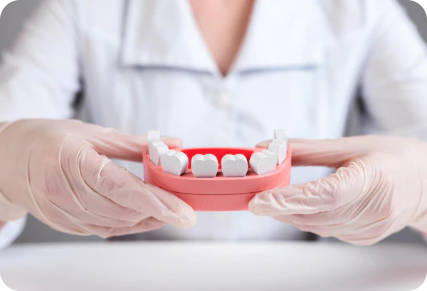Dental Implants
If you are searching for a long- term replacement for missing teeth, look no further than dental implants



Experience the closest thing to a natural tooth to date…
- Jaw bone deterioration and a sunken-in look
- Tooth movement and bite changes
- Gum recession
- Overloading of surrounding teeth
How dental implants replace missing teeth
The parts of a dental implant
The Implant
This is the artificial root attached to the jawbone. It is made from biocompatible material so as to have a higher chance of successfully bonding with the tooth.
The Abutment
It is attached to the implant with a screw and is used to connect the implant to the crown (the restoration). This part is usually made of titanium, gold, or porcelain.
The Restoration
This can be an artificial tooth made from porcelain or a metal alloy. It resembles a natural tooth since it is visible and is bonded or screwed to the abutment. The restoration can also be a bridge (two or more artificial teeth) or a denture.
Receiving dental implants
Once you have attended your initial consultation we will identify if dental implants would be a suitable option to replace your missing teeth. Our dental professionals will then tailor a treatment plan with your specific needs in mind.
Once we are ready to commence treatment our dental professionals will surgically place the dental implant in the jawbone and allow time for the implant to bond with the jawbone and become a fully functioning element.
The dental implant treatment process
There are 2 methods for placing a dental implant:
Two-stage procedure
This procedure involves two surgeries to complete. In the first procedure, the dental implant is attached to the jawbone (below the gum tissue so it isn’t visible) and the gum tissue is re-stitched.
Once the surrounding gum tissue has healed, the second procedure is conducted. During this surgery, a metal post (the abutment) is connected to the implant, which was attached during the first surgery. An artificial tooth (the crown) is attached to the post creating your long-term artificial teeth.
Single-stage procedure
As the name suggests, this procedure involves one surgery and is only performed when the patient has insufficient bone height (which is required for the two-stage procedure).
A long metal implant is surgically fitted onto the jawbone below the gum tissue (only the implant’s head remains visible).
The gum is stitched up and the patient is sent home for recovery. Once healed, the artificial tooth can fit onto the implant head without the need for further surgery. Subperiosteal implants are used for this procedure.
The benefits of dental implants
More stability
Dental implants provide more stability because they are fitted into the jawbone. Which means they provide support for artificial teeth. This helps to prevent restorations (mounted dental bridges and dentures) from moving around.
More natural
Thanks to their permanence and stability, dental implants can feel natural. Most patients don’t notice any difference between their dental implant and a healthy tooth root.
Improves function
The artificial teeth improve function because they are securely fitted and feel natural. This makes daily activities such as eating and speaking easier.
Better oral health
Regular bridges use the surrounding teeth as an anchor, which may require altering your natural teeth (like shaving it down to accommodate crowns).
Dental implants don’t require surrounding teeth to be altered, so you can keep more of your natural teeth intact.
Convenient
Dental implants won’t slip out of your mouth (as may accidentally happen with dentures) saving you the embarrassment. They also do not require any unpleasant adhesives to keep them in place.
Durable
If properly cared for, dental implants can last you a lifetime since they are attached directly to your jawbone. Dental implants may fall out as a result of injury, trauma, or gum disease.
